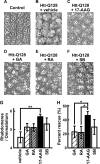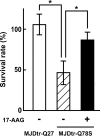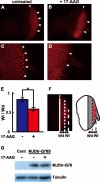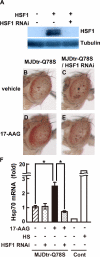Heat shock transcription factor 1-activating compounds suppress polyglutamine-induced neurodegeneration through induction of multiple molecular chaperones
- PMID: 18632670
- PMCID: PMC3258858
- DOI: 10.1074/jbc.M710521200
Heat shock transcription factor 1-activating compounds suppress polyglutamine-induced neurodegeneration through induction of multiple molecular chaperones
Abstract
Many neurodegenerative diseases including Alzheimer, Parkinson, and polyglutamine (polyQ) diseases are thought to be caused by protein misfolding. The polyQ diseases, including Huntington disease and spinocerebellar ataxias (SCAs), are caused by abnormal expansions of the polyQ stretch in disease-causing proteins, which trigger misfolding of these proteins, resulting in their deposition as inclusion bodies in affected neurons. Although genetic expression of molecular chaperones has been shown to suppress polyQ protein misfolding and neurodegeneration, toward developing a therapy, it is ideal to induce endogenous molecular chaperones by chemical administration. In this study, we assessed the therapeutic effects of heat shock transcription factor 1 (HSF1)-activating compounds, which induce multiple molecular chaperones, on polyQ-induced neurodegeneration in vivo. We found that oral administration of 17-(allylamino)-17-demethoxygeldanamycin (17-AAG) markedly suppresses compound eye degeneration and inclusion body formation in a Drosophila model of SCA. 17-AAG also dramatically rescued the lethality of the SCA model (74.1% rescue) and suppressed neurodegeneration in a Huntington disease model (46.3% rescue), indicating that 17-AAG is widely effective against various polyQ diseases. 17-AAG induced Hsp70, Hsp40, and Hsp90 expression in a dose-dependent manner, and the expression levels correlated with its therapeutic effects. Furthermore, knockdown of HSF1 abolished the induction of molecular chaperones and the therapeutic effect of 17-AAG, indicating that its therapeutic effects depend on HSF1 activation. Our study indicates that induction of multiple molecular chaperones by 17-AAG treatment is a promising therapeutic approach for a wide range of polyQ diseases and possibly other neurodegenerative diseases.
Figures







Similar articles
-
[Molecular therapy targeting protein misfolding and aggregation for the polyglutamine diseases].Rinsho Shinkeigaku. 2009 Nov;49(11):913-6. doi: 10.5692/clinicalneurol.49.913. Rinsho Shinkeigaku. 2009. PMID: 20030247 Review. Japanese.
-
Modulation of Hsp90 function in neurodegenerative disorders: a molecular-targeted therapy against disease-causing protein.J Mol Med (Berl). 2006 Aug;84(8):635-46. doi: 10.1007/s00109-006-0066-0. Epub 2006 Jun 2. J Mol Med (Berl). 2006. PMID: 16741751 Review.
-
Induction of molecular chaperones as a therapeutic strategy for the polyglutamine diseases.Curr Pharm Biotechnol. 2010 Feb;11(2):188-97. doi: 10.2174/138920110790909650. Curr Pharm Biotechnol. 2010. PMID: 20166962 Review.
-
Molecular stress-inducing compounds increase osteoclast formation in a heat shock factor 1 protein-dependent manner.J Biol Chem. 2014 May 9;289(19):13602-14. doi: 10.1074/jbc.M113.530626. Epub 2014 Apr 1. J Biol Chem. 2014. PMID: 24692538 Free PMC article.
-
Induction of multiple heat shock proteins and neuroprotection in a primary culture model of familial amyotrophic lateral sclerosis.Neurobiol Dis. 2006 Nov;24(2):213-25. doi: 10.1016/j.nbd.2006.06.017. Epub 2006 Sep 6. Neurobiol Dis. 2006. PMID: 16950627
Cited by
-
Vaccinia-Related Kinase 2 Controls the Stability of the Eukaryotic Chaperonin TRiC/CCT by Inhibiting the Deubiquitinating Enzyme USP25.Mol Cell Biol. 2015 May;35(10):1754-62. doi: 10.1128/MCB.01325-14. Epub 2015 Mar 9. Mol Cell Biol. 2015. PMID: 25755282 Free PMC article.
-
Using the drug-protein interactome to identify anti-ageing compounds for humans.PLoS Comput Biol. 2019 Jan 9;15(1):e1006639. doi: 10.1371/journal.pcbi.1006639. eCollection 2019 Jan. PLoS Comput Biol. 2019. PMID: 30625143 Free PMC article.
-
Brain-permeable small-molecule inhibitors of Hsp90 prevent alpha-synuclein oligomer formation and rescue alpha-synuclein-induced toxicity.J Pharmacol Exp Ther. 2010 Mar;332(3):849-57. doi: 10.1124/jpet.109.158436. Epub 2009 Nov 24. J Pharmacol Exp Ther. 2010. PMID: 19934398 Free PMC article.
-
Altered chromatin architecture underlies progressive impairment of the heat shock response in mouse models of Huntington disease.J Clin Invest. 2011 Aug;121(8):3306-19. doi: 10.1172/JCI57413. Epub 2011 Jul 25. J Clin Invest. 2011. PMID: 21785217 Free PMC article.
-
Modifiers and mechanisms of multi-system polyglutamine neurodegenerative disorders: lessons from fly models.J Genet. 2010 Dec;89(4):497-526. doi: 10.1007/s12041-010-0072-4. J Genet. 2010. PMID: 21273704 Review.
References
-
- Ross, C. A., and Poirier, M. A. (2005) Nat. Rev. Mol. Cell Biol. 6 891-898 - PubMed
-
- Gusella, J. F., and MacDonald, M. E. (2000) Nat. Rev. Neurosci. 1 109-115 - PubMed
-
- Zoghbi, H. Y., and Orr, H. T. (2000) Annu. Rev. Neurosci. 23 217-247 - PubMed
-
- Bence, N. F., Sampat, R. M., and Kopito, R. R. (2001) Science 292 1552-1555 - PubMed
-
- Nagai, Y., Onodera, O., Chun, J., Strittmatter, W. J., and Burke, J. R. (1999) Exp. Neurol. 155 195-203 - PubMed
Publication types
MeSH terms
Substances
LinkOut - more resources
Full Text Sources
Medical
Molecular Biology Databases

